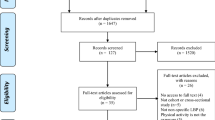Abstract
The objective of this cross-sectional study was to study associations between low back pain (LBP) and modes of transport to school and leisure activities among adolescents. The study population included all adolescents in eighth and ninth grade in two geographic areas in eastern Norway. Eighty-eight adolescents participated (mean age 14.7 years), making the response rate 84%. Data concerning active (walking/bicycling) and passive (bus/car) journeys were obtained from lists and maps from local authorities, and from the pupils, using a questionnaire that also included LBP, activities and wellbeing. Distance walked/bicycled to school was slightly shorter among those reporting LBP in bivariate analyses. Walking/bicycling more than 8 km weekly to regular activities was inversely associated with LBP in multivariate analysis (OR 0.3; 95% confidence interval 0.1–1.0). No associations were found between passive journeys and LBP. The results raise the question for future research of whether lack of active transport may be one cause behind the increase in juvenile LBP.



Similar content being viewed by others
References
Andersson GBJ (1997) The epidemiology of spine disorders. In: Frymoyer JW (ed) The adult spine: principles and practice, 2nd edn, vol 1. Lippincott-Raven, Philadelphia
Balague F, Troussier B, Salminen JJ (1998) Non-specific low back pain in children and adolescents: risk factors. Eur Spine J 8:429–438
Biering-Sorensen F (1983) A prospective study of low back pain in the general population. Scand Rehabil Med 15:81–88
Bovenzi M, Hulshof CT (1999) An updated review of epidemiologic studies on the relationship between exposure to whole-body vibration and low back pain (1986–1997). Int Arch Occup Environ Health 72:351–365
Department of Transport (1995) National travel survey 1992–4. HMSO, London
Feldman DE (1998) Risk factors for the development of low back pain in adolescents. Thesis, McGill University
Frymoyer JW (1996) Magnitude of the problem. In: Wiesel SW, Weinstein JN (eds) The lumbar spine, vol 1. Saunders, Philadelphia, pp 8–16
Gunzburg R, Balague F, Nordin M, Szpalski M, Duyck D, Bull D, Melot C (1999) Low back pain in a population of school children. Eur Spine J 8:439–443
Hagen KB, Holte HH, Tambs K, Bjerkedal T (2000) Socioeconomic factors and disability retirement from back pain. A 1983–1993 population-based prospective study in Norway. Spine 25:2480–2487
Harreby M, Nygaard B, Jessen T, Larsen E, Storr-Paulsen A, Lindahl A, Fisker I, Laegaard E (1999) Risk factors for low back pain in a cohort of 1389 Danish school children: an epidemiologic study. Eur Spine J 8:444–450
International Organisation for Standardisation (1997) ISO 2631–1-1997. Mechanical vibration and shock—evaluation of human exposure to whole-body vibration. 1. General requirements. ISO, Geneva
Kuorinka I, Jonsson B, Kilbom A, Vinterberg H, Biering-Sørensen F, Andersson G, Jörgensen K (1987) Standardised Nordic questionnaire for the analysis of musculoskeletal symptoms. Appl Ergon 18:233–237
Morris JN, Hardman AE (1997) Walking to health. Sports Med 23:306–332
National Bureau of Statistics (1984) Standard classification of socio-economic status. National Bureau of Statistics, Oslo
Negrini S, Carabalona R, Pinochi G, Malengo R, Sibilla P (1998) Backpack and back pain in school children: is there a direct relationship? J Bone Joint Surg Br 80 [Suppl 3]:247
Oia T (1994) Norwegian youth cultures (in Norwegian). Opplandske Bokforlag, Stange
Rose G (2001) Sick individuals and sick populations. Reiteration. Int J Epidemiol 30:427–432
Salminen JJ, Pentti J, Terho P (1992) Low back pain and disability in 14-year-old schoolchildren. Acta Paediatr 81:1035–1039
Sjolie AN (2000) Pedestrian roads access, daily activities and physical performance in adolescents. Spine 25:1965–1972
Sjolie AN (2002) Psychosocial correlates of low back pain in adolescents. Eur Spine J 11:582–588
Solstad KJ (1973) School bus and physical health (in Norweigian, English summary). University of Tromso
Szpalski M, Gunzburg R, Balague F, Nordin M, Melot C (2002) A 2-year longitudinal study on low back pain in primary school children. Eur Spine J 11:459–464
Tambs K, Moum T (1993) Low genetic effect and age-specific family effect for symptoms of anxiety and depression in nuclear families, halfsibs and twins. J Affect Disord 27:183–195
US Surgeon General (1996) Physical activity and health. A report from the Surgeon General. National Center of Chronic Disease Prevention and Health Promotion, Atlanta
Vibe N (1993) Our daily travels. Alterations in travel habits among Norwegians from 1982 to 1992 (in Norwegian). Report 17. Institute of Communication, Oslo
Videman T, Battie MC (1999) The influence of occupation on lumbar degeneration. Spine 24:1164–1168
Vikat A, Rimpelä M, Salminen JJ, Rimpelä A, Savolainen A, Virtanen SM (2000) Neck or shoulder pain and low back pain in Finnish adolescents. Scand J Public Health 28:164–173
Viry P, Creveuil C, Marcelli C (1999) Nonspecific back pain in children. A search for associated factors in 14-year-old schoolchildren. Rev Rhum Engl Ed 66:381–388
Volinn E (1997) The epidemiology of low back pain in the rest of the world. Spine 22:1747–1754
Acknowledgement
A.E. Ljunggren, F. Balague, and F. Thuen are acknowledged for valuable discussions.
Author information
Authors and Affiliations
Corresponding author
Rights and permissions
About this article
Cite this article
Sjolie, A.N. Active or passive journeys and low back pain in adolescents. Eur Spine J 12, 581–588 (2003). https://doi.org/10.1007/s00586-003-0557-4
Received:
Revised:
Accepted:
Published:
Issue Date:
DOI: https://doi.org/10.1007/s00586-003-0557-4




